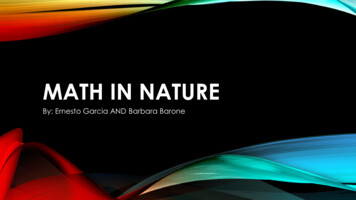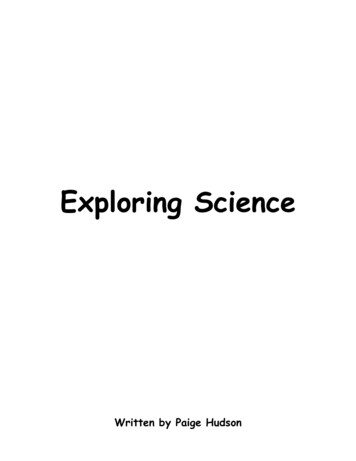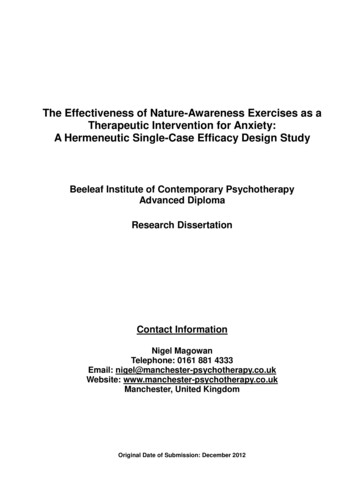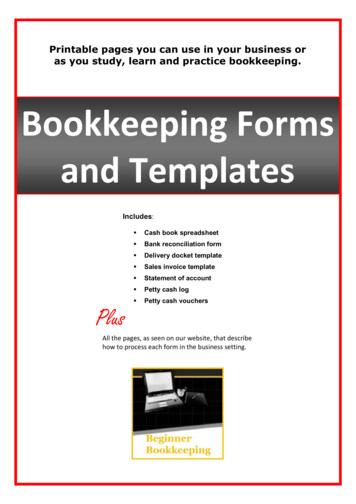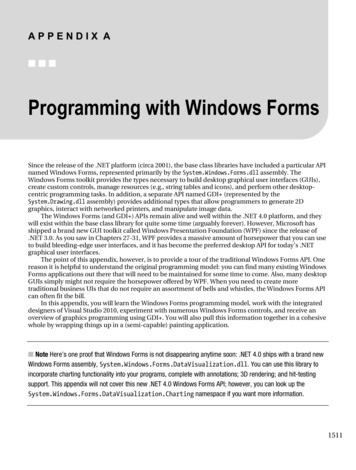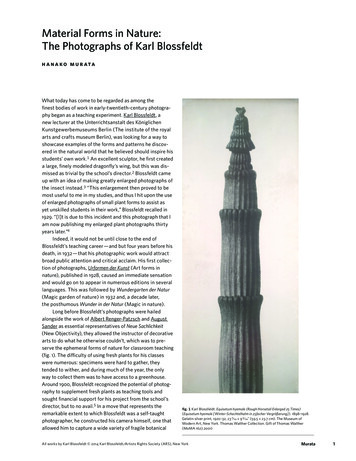
Transcription
Material Forms in Nature:The Photographs of Karl BlossfeldtH a n a ko M u r ataWhat today has come to be regarded as among thefinest bodies of work in early-twentieth- century photography began as a teaching experiment. Karl Blossfeldt, anew lecturer at the Unterrichtsanstalt des KöniglichenKunstgewerbe museums Berlin (The institute of the royalarts and crafts museum Berlin), was looking for a way toshowcase examples of the forms and patterns he discovered in the natural world that he believed should inspire hisstudents’ own work.1 An excellent sculptor, he first createda large, finely modeled dragonfly’s wing, but this was dismissed as trivial by the school’s director.2 Blossfeldt cameup with an idea of making greatly enlarged photographs ofthe insect instead. 3 “This enlargement then proved to bemost useful to me in my studies, and thus I hit upon the useof enlarged pho tographs of small plant forms to assist asyet unskilled students in their work,” Blossfeldt recalled in1929. “[I]t is due to this incident and this photograph that Iam now publishing my enlarged plant photographs thirtyyears later.”4Indeed, it would not be until close to the end ofBlossfeldt’s teaching career — and but four years before hisdeath, in 1932 — that his photographic work would attractbroad public attention and critical acclaim. His first collection of photographs, Urformen der Kunst (Art forms innature), published in 1928, caused an immediate sensationand would go on to appear in numerous editions in severallanguages. This was followed by Wundergarten der Natur(Magic garden of nature) in 1932 and, a decade later,the posthumous Wunder in der Natur (Magic in nature).Long before Blossfeldt’s photographs were hailedalongside the work of Albert Renger- Patzsch and AugustSander as essential representatives of Neue Sachlichkeit(New Objectivity), they allowed the instructor of decorativearts to do what he otherwise couldn’t, which was to preserve the ephemeral forms of nature for classroom teaching(fig. 1). The difficulty of using fresh plants for his classeswere numerous: specimens were hard to gather, theytended to wither, and during much of the year, the onlyway to collect them was to have access to a greenhouse.Around 1900, Blossfeldt recognized the potential of photography to supplement fresh plants as teaching tools andsought financial support for his project from the school’sdirector, but to no avail.5 In a move that represents theremarkable extent to which Blossfeldt was a self- taughtphotographer, he constructed his camera himself, one thatallowed him to capture a wide variety of fragile botanicalfig. 1 Karl Blossfeldt. Equisetum hyemale (Rough Horsetail Enlarged 25 Times)(Equisetum hyemale [Winter-Schachtelhalm in 25facher Vergrößerung]). 1898–1928.Gelatin silver print, 1920–32, 23 7/16 9 5/16" (59.5 23.7 cm). The Museum ofModern Art, New York. Thomas Walther Collection. Gift of Thomas Walther(MoMA 1627.2001)All works by Karl Blossfeldt 2014 Karl Blossfeldt/Artists Rights Society (ARS), New YorkMurata1
specimens in both horizontal and vertical orientations.6With a bellows approximately one meter long, the cameraalso permitted him to magnify even the tiniest and mostdelicate plant forms, which he printed at a scale considerable for the time.7 Over the course of the next thirty years,Blossfeldt would produce hundreds of prints that are striking for both the elegant simplicity of their compositionsand the uniform precision of their production: botanicalspecimens, magnified to various degrees, are shown inisolation against a plain background.A letter written by Blossfeldt to the director of theKönigliche Kunstgewerbemuseum in April 1906 is tellingin many regards:I hereby respectfully submit to the director a collection ofenlargements of plants. Some of the main subject teachers towhom these photographs have recently been shown havebeen positive in their comments and consider them suitablefor lessons. . . . In many cases, these photographs were made by enlarging small details that students could not easily make out inevening light. . . . I probably have more than a thousand of suchphotographs, from which, however I can only slowly makeprints. Because they are the fruit of years of work and considerable material sacrifice, I would very much welcome their beingused in some way, either as inspirational material in individualclasses, libraries, etc. for a wider audience and, above all, forall students. . . . T he sculptor . . . c an only make profitable use ofthe smaller, simpler plants that grow wild. There plants area treasure trove of forms — one which is carelessly overlookedonly because the scale of shapes fails to catch the eye andsometimes this makes the forms hard to identify. But that isprecisely what these photographs are intended to do — to portray diminutive forms on a convenient scale and encouragestudents to pay them more attention. . . . To facilitate discussion of these photographs, I feel itwould be advisable to affix these prints in advance to a wall.I will gladly be of service here. There are 210 sheets measuring20 30 cm each, and they would require an area of around12 square meters.8Blossfeldt makes clear that by 1906 he had already mademore than a thousand negatives and at least 210 enlargedprints, 7 7/8 by 11 13/16 inches (20 by 30 centi meters) each,and he expresses a desire to see the fruits of his labor find abroader audience. Slowly but surely, interest in Blossfeldt’swork began to expand. In 1920, the institute in Berlin whereBlossfeldt taught purchased thirty prints, 9 7/16 by 11 13/16inches (24 by 30 centi meters) each.9 Blossfeldt’s work wasexhibited at the school in 1925, which may have led to itsdiscovery by the influential gallery owner and art collectorKarl Nierendorf. The following year, Nierendorf mountedthe first exhibition of Blossfeldt’s images outside the academic context at the eponymous gallery he had establishedwith his brother in Berlin; Blossfeldt was sixty- one.10 Thesuccess of the exhibition expedited the publication ofUrformen der Kunst, with the result that Blossfeldt’s photographs were included a year later in both the Stuttgartand the Berlin venues of the landmark 1929 exhibition Filmund Foto.11 He retired on October 1, 1930, and died twoyears later at the age of sixty- seven.12In the decades that have followed, Blossfeldt’s exquisite body of work has continued to attract widespreadinterest, even as exhibition of his original prints is relativelyrare. The group of seven gelatin silver prints in the ThomasWalther Collection at The Museum of Modern Art is thelargest collection of Blossfeldt prints outside his nativeGermany, and it offers a unique opportunity to understandtrends in the artist’s work through data gathered from closeexamination and instrumental analysis of his materialchoices. This examination — the first to consider the materialaspects of Blossfeldt’s photography — also provides insightsinto critical questions surrounding the dating of theartist’s work as well as additional perspective on exactlyhow this visionary pioneer achieved his trademark consistency of style.13Blossfeldt’s ultimate vision of a characteristic, relativelyhomogenous style would have started with the negative.From existing documentation we know that he made atleast some of his negatives in soft daylight so he couldbetter capture the details of his plant specimens in an eventone, using an Aplanat 1:36, F 50-cm lens and an exposuretime of eight to twelve minutes.14 An examination ofdata for 460 negatives in the online catalogues of boththe archive of the Universität der Künste Berlin and theDeutsche Fotothek, SLUB, Dresden, determined thatBlossfeldt used four major formats of glass- plate negatives:6 by 9 centimeters (2 3/8 by 3 9/16 inches), 9 by 12 centimeters(3 9/16 by 4 3/4 inches), 9 by 18 centimeters (3 9/16 by 7 1/8inches), and 13 by 18 centimeters (5 1/8 by 7 1/8 inches), thelatter three accounting for 96 percent of his negatives.15Such large- format negatives would have been moreexpensive to produce, but Blossfeldt likely found the benefits outweighed the cost, considering that larger negativesare easier to retouch and require less enlargement (thusproviding sharper images).The striking uniformity of Blossfeldt’s photographssuggests an excellent mastery of studio technique,and indeed, for all the prints’ subsequent associations withNew Objectivity, Blossfeldt’s work was decidedly subjective, insofar as he was not shy about modifying his subjectsor his images to achieve his final vision. Not only did hecarefully select, arrange, and in some cases physically modify his specimens, but his meticulous attention to detailand image refinement continued throughout each step ofproduction, beginning with his negatives. Firsthand examination of 110 of Blossfeldt’s glass- plate negatives at theDeutsche Fotothek revealed that the artist readilyretouched and carried out chemical intensification (toMurata2
increase image density) and reduction (to reduce density),both overall and locally. These steps allowed him to attainthe characteristic uniform image density in his prints,from highlights to deep shadows, without the loss of mid- tone detail. Blossfeldt’s impressive skills at retouchingwere no less instrumental to achieving his desired effect,and he used various materials, including pencil (either soft,dark- colored pencil or graphite) and varying degrees oflight- and dark- colored wash applied with a brush.16Examination indicated that while Blossfeldt did sometimesreinforce the outlines of the plant forms or, on occasion,extensively re-form the image, it is on the backgrounds thatwe see the most evidence of retouching, such as the elimination of white dots or halos that would have marred thefinished photographs with black spots. Such painstakingretouch of the negatives ensured a clean background, voidof distracting marks, which is essential to the ultimateimpact of Blossfeldt’s final prints.17In the service of his particular vision, it appears thatBlossfeldt did not hesitate to retouch his prints as well(figs. 2–6).18 Although the materials and techniqueshe used were common at the time, the surface work isfigs. 2, 3 Examples of retouch on Blossfeldt prints in the Walther Collection:Equisetum hyemale (MoMA 1627.2001), additive retouch using aqueous mediumto delineate plant edges (area of detail is 13 19 mm); Saxifraga wilkommiana(MoMA 1629.2001), additive retouch using aqueous medium to delineate plant tipand edges (area of detail is 6 8 mm). Courtesy Hanako MurataMurata3
figs. 4–6 Examples of retouch on Blossfeldt prints in the Walther Collection:Acanthus mollis (MoMA 1625.2001), additive retouch using pencil to emphasizedetail of vein pattern (area of detail is 13.5 18.5 mm); Chrysanthemum segetum(MoMA 1629.2001), reductive retouch by etching print surface to reduce unwantedblack dots (area of detail is 2 1.3 mm); Passiflora (MoMA 1631.2001), additiveretouch using pencil to hide white shadow of pin made during lateral enlargement(area of detail is 4 3.5 mm). Courtesy Hanako MurataMurata4
remarkable for its near invisibility to the naked eye. Undermagnification, however, a world of image modificationand enhancement can be readily observed. The Blossfeldtprints in the Walther Collection, with their matte surfacesheen and delicate paper texture, exhibit pencil and washapplications. For comparative purposes, 195 prints wereexamined at the Universität der Künste Berlin and thePinakothek der Moderne Munich, and these photographsexhibited the same retouching materials and techniques asthe Walther prints, with washes observed in a variety oftones, some of which may be due to color shifts over time.The pencil, on the other hand, perfectly matched the colorand texture of Blossfeldt’s photographic paper, as is beautifully demonstrated on Acanthus mollis. The outlines andtips in many of the plant forms have been enhanced with afine brushstroke, and additive retouches of lines of color toemphasize and reinforce the forms of the plants and theveins of leaves, stems, or stalks are evident as well. In addition to these additive techniques, Blossfeldt also employedreductive ones, excising minute portions of the emulsionto achieve a light, speck- free background and fine scratchmarks to enhance shapes. Such intense workmanship onboth his negatives and prints yielded stunning results:photographs that showcase in dramatic detail often minute botanical forms with clear contours and flawlessbackgrounds that might serve as inspiration for Blossfeldt’sstudents — and ultimately come to be regarded as artworks in their own right.During the course of his career, Blossfeldt made morethan 1,600 prints, and his ability to attain such an exceptional degree of precision and uniformity relied on manyfine, meticulous adjustments as he enlarged his negativesonto photographic paper. Even as he employed but a relative handful of backgrounds, staging methods, and lightingeffects in his studio, there were nevertheless many irregularities he had to contend with. For example, he oftenphotographed several plants at a time, which appear in asingle negative (fig. 7). While this allowed him to economize, it could also result in different image densities inboth the backgrounds and the specimens themselves anda negative with either excessive or insufficient contrast.Yet in Blossfeldt’s final prints, the specimens share similarproportions within the paper, the highlights are consistent,and the image density is maximized without loss of midtone details.fig. 7 Karl Blossfeldt. Acanthus and Scabious. Before 1928. Thirty-three contactprints of various photographic processes mounted on cardboard, 21 25 3/4"(50 65.5 cm). Karl Blossfeldt Archiv/Stiftung Ann und Jürgen Wilde, Pinakothekder Moderne, Munich. One of Blossfeldt’s so-called working collages — he oftenphotographed multiple plant specimens on one negative, resulting in a variety ofimage sizes, densities, background tonalities, and contrasts. The contact printof the negative Acanthus mollis (MoMA 1625.2001) with white background appearsin the second row, fourth from left.Murata5
Tantalizing clues regarding Blossfeldt’s enlargementprocess can be found on the verso of many of his prints,including those in the Walther Collection. There, graphiteinscriptions often identify the name of the plant specimenas well as magnification and coding that consists of letters and numbers. Each of the Walther prints exhibitsinscriptions in Blossfeldt’s handwriting, based on comparison to known examples, although some inscriptions are byBlossfeldt collector Jürgen Wilde or another person, as yetunidentified.19 Blossfeldt used a mix of older Germanblackletter handwriting as well as Sütterlinschrift, a scriptadopted in Germany in 1915. Such inscriptions are notuncommon: when photographers make multiple printsfrom the same negative over time, they often record information such as lens, f- stop, distance and positioningbetween negative and paper, and exposure time in order toreplicate their work later. They may even note the type ofpaper used. Previous studies have remarked upon thedegree of variation in the magnification and other codingthat Blossfeldt inscribed on prints of the same image, andthe photographer’s prints in the Walther Collection are noexception.20 It is not known at this time whether this is dueto an inconsistency in recording or whether Blossfeldt’scode evolved over time. He did make at least one formalcomment about his process: in Das Deutsche Lichtbild hereported that he enlarged a 9-by-12-cm (3 9/16-by-4 3/4inch) negative onto 30-by-40-cm (11 13/16-by-15 3/4-inch)Lumarto paper manufactured by Leonar- Werke, a gaslightpaper most likely comprised of a silver chlorobromideemulsion, as well as onto 30-by-40-cm Bromid, a silverbromide paper by Agfa.21 Evidence of Blossfeldt’s enlargement process can be seen on his prints as well. All sevenprints in the Walther Collection, as well as most of theprints examined by the author in other collections, havepinholes in each of their four corners and occasionally a fewpinholes along the sides. Especially visible in prints withdark backgrounds, the shadows of the pins are seen ashighlights, which Blossfeldt retouched with dark color.These pinholes signal the use of a lateral enlargement process, in which the paper is mounted vertically oppositethe enlarger (fig. 8).22The following highlights some of the coded inscriptionsseen on the seven Blossfeldt prints in the WaltherCollection (figs. 9, 10), which were compared with information from the online database of the UdK Berlin Archiveregarding the inscriptions on other Blossfeldt images. 23Because different codes appear on prints made fromthe same negative, it does not seem as if Blossfeldt’s codingsystem is related to identification of the negative used orthe plant specimen. Two numbers with an “f” or “- ” in between (e.g., “230f12”):Among photographers in general, an “f” appearing betweennumbers typically suggests focal length of lens (in millimeters) and f- stop (aperture of lens/opening). However, it isfig. 8 Advertisement for a Curry Utility Enlarging and Cropping Board, a horizontalenlarger, showing photographic paper affixed with pins. Reproduced in John A.Tennant, Bromide Printing and Enlarging: A Practical Guide to the Making of BromidePrints by Contact, and Bromide Enlarging by Daylight and Artificial Light, with the Toningof Bromide Prints and Enlargements (New York: Tennant and Ward), 1912.figs. 9, 10 Details of the versos of Adiantum pedatum (MoMA 1626.2001)and Hordeum distichum (MoMA 1630.2001), showing inscriptions. CourtesyHanako Murataalso possible that Blossfeldt recorded information about theenlargement process, such as exposure time (most likelyin seconds) or the distance (in millimeters or centimeters)between the unexposed paper and the lens, negative, orother point on the enlarger. We know that Blossfeldt used acamera of his own construction; he may also have used amodified enlarger as well, which may have had nonstandardf- stop measurements. Prints of the same image enlarged tosimilar size do not have the same inscriptions. Further studyis necessary to understand Blossfeldt’s coding system. “abgeschn” or “abg.”: abgeschw or abgeschn translatesdirectly as “attenuated.” In the context of Blossfeldt’sinscriptions, these likely mean “lighten,” “weaken,”“reduce,” or “make thin.” Through a comparison with theonline catalogue of the UdK Berlin Archive, ninety- threeBlossfeldt prints were found to have this inscription.Tellingly, the word is most often written after the numberswith “f,” which strongly indicates that the “f” or “- ” inscription refers to the enlarging process.24Murata6
“hy” or “hg”: more research is needed to determine themeaning of these inscriptions. At present, it is not certainthat they are written in Blossfeldt’s hand, or whether “hy” or“hg” is an accurate transcription. They may also refer towords in Greek or Latin. The inscription can be found on ahundred prints in the online catalogue of the UdK BerlinArchive, sometimes with viel (“much” or “lots”), unten(“down”), and mit or Mitt (“also” or “as well”). The majorityare written following numbers, such as “30f12 hy” or “15 hy.” “K 75” or “K”: these inscriptions are always written inthe second row and separate from other inscriptions. Oneprint with “K” and four with “K 75” can be found in theWalther Collection; the latter all share the same materialpaper characteristics (see discussion below). In addition,forty- seven prints with “K 75” are found in the online catalogue of the UdK Berlin Archive. Blossfeldt could haveused such codes to identify the paper he used. Historically,manufacturers of photographic paper used an alphanumeric system to identify their products. However, eachcompany used its own codes, and product lines changedover time, making it extremely difficult to identify a print’spaper based on such coding unless the date and information about the paper’s manufacturer is also present. Forexample, the code “K” was used by Berlin- based NeuePhotographische Gesellschaft to denote a “matte,middle heavy, white” gaslight paper, and it was also usedby Mimosa of Dresden to identify its Platin- Bromsilver, aglossy, white, heavy-weight, high- contrast paper.25 “N88”: located on the verso of Equisetum hyemale. Thehandwriting is probably Blossfeldt’s but cannot be definitively confirmed. Rajka Knipper suggests that “N” witha number indicates prints that are part of Blossfeldt’s“working collages,” contact print sheets that Blossfeldtmade from his negatives.26 Indeed, eighteen prints codedwith “N,” including Equisetum hyemale, are all included inBlossfeldt’s working collages (fig. 7).The format of 719 Blossfeldt prints was compared to that ofthe seven prints in the Walther Collection. Six of the WaltherCollection prints are approximately 24 by 30 centimeters(9 7/16 by 11 13/16 inches), while the last, Equisetum hyemale,is an unusual and striking 59.5 by 23.7 centimeters (23 7/16 by9 5/16 inches). Blossfeldt primarily used three print sizes — 12 by 30 centimeters (4 3/4 by 11 13/16 inches), 20 by 30centi meters (7 7/8 by 11 13/16 inches), and 24 by 30 centimeters(9 7/16 by 11 13/16 inches) — employing the latter two for 75percent of his known prints. His paper sizes can be mappedagainst the standard print sizes that were available duringfig. 11 Comparison of surface textures on the rectos of the seven Blossfeldtprints in the Walther Collection. The first row shows the entire recto of the print;the second row shows a magnified color image of a section of the print surface(3 3 mm) under raking light; the third row shows the same image in black andwhite to enhance the texture pattern. Left to right: Acanthus mollis (MoMA1625.2001), Hordeum distichum (MoMA 1630.2001), Passiflora (MoMA 1631.2001),Saxifraga wilkommiana (MoMA 1628.2001), Equisetum hyemale (MoMA 1627.2001),Adiantum pedatum (MoMA 1626.2001), and Chrysanthemum segetum (MoMA1629.2001). The results are grouped to show similar papers.Murata7
IMAGETITLEAcanthus tumMoMA ACCESSION 26.20011629.2001HARDWOOD BLEACHED SULFITE–111––2S T R AW272732353915–R AG (COT TO N )18171317141138BAST43456220SOFTWOOD BLEACHEDK R A F T/ S O D A––––1––SOFTWOOD BLEACHED SULFITE51525141417241fig. 12 Results of fiber-content analysis conducted on the seven Blossfeldt printsin the Walther Collection, giving percentages of fiber type per print.the 1920s and 1930s.27 In the German market, this primarilyincluded 24 by 30 centi meters and 30 by 40 centimeters(11 13/16 by 15 3/4 inches), suggesting that for Blossfeldt’ssmaller print sizes, he used the 30-centimeter length forthe longer side and cut the paper to fit the shorter one. Itseems the photographer logically chose a full- sized sheetof 24-by-30-centimeter paper for the square- or round- shaped plant specimens he photographed and utilized ahalf- sized 30-by-40-centimeter sheet for long verticalspecimens. The largest size available without resorting toan uncut roll of paper was 60 by 50 centimeters (23 5/8 by19 11/16 inches), which likely explains the unusual size ofEquisetum hyemale: Blossfeldt probably cut this paperapproximately in half.A closer technical examination of the paper Blossfeldtused for the Walther prints serves as an example ofthe insights that can be discovered regarding a photographer’s practice through the systematic gathering andcomparison of data from multiple photographs within a collection. The seven prints appear very similar, yet detailedresearch reveals that Blossfeldt used at least three differentphotographic papers, a fact that could be of significance inanswering key questions about his career, such as helpingto narrow the dates of his prints. The very fact that hispapers appear almost indistinguishable but are in fact notalways the same serves as further evidence of the care hetook to ensure remarkable consistency. Five materialaspects of the photographic paper used by Blossfeldt wereevaluated through technical analysis: image surface sheen,surface textures (recto and verso), print thickness, paperfiber content, and inorganic composition based on X- rayfluorescence analysis (XRF; again, both recto and verso).Various and somewhat inconsistent terms wereused in the photographic-paper industry to describe surface sheen.28 For the purposes of this study, sheen wasclassified as glossy, semireflective, and matte. Each of theBlossfeldt prints in the Walther Collection have nearlyidentical matte surfaces, and at first glance, the subtlesurface texture looks almost identical as well. When theprints are examined under a microscope with raking light,however, finely nuanced differences appear in threedimensions. Unique crisscross patterns characteristic ofthose formed by fibers appear in two prints, Adiantumpedatum and Chrysanthemum segetum, whereas there is adistinctive pitting (or dots) on the large- scale Equisetumhyemale (fig. 11).The paper thickness of the prints was also evaluated,and six measured between .170 and .179 millimeters (witha margin of error of /- .003 milli meters).29 These can begrouped as such: a) Acanthus mollis (.179 milli meters),Saxifraga wilkommiana (.179 milli meters), and Hordeumdistichum (.178 millimeters); b) Adiantum pedatum (.173millimeters) and Equisetum hyemale (.174 millimeters); andc) Chrysanthemum segetum (.170 millimeters). Surprisingly,Passiflora registered at two different thickness values,making it difficult to compare with the others.30 All sevenprints can be categorized as being on single- weight paper.Although Blossfeldt’s prints do not feel particularly fragileMurata8
when handled, when their paper thickness was comparedto 221 prints in the Walther Collection they were amongthe thinner prints, even among single- weight prints andeven as they are some of the larger prints overall. Theseresults were rather unexpected. Double- weight paperfor larger prints would be a more natural choice, since theextra weight would give the prints greater physical stabilityover time (especially if they were intended for classroomuse). Neither are the Walther prints mounted on thickerboard. Blossfeldt’s choice of thinner paper could be dueto a number of factors, including the fact that single- weightpaper was less expensive than heavier paper, requires lesswashing and drying time, and was more readily available.It is the analysis of fiber content that appears to offerthe most promise in efforts to more accurately establishdates for Blossfeldt’s prints. Prior research has shown thatfiber content in photographic paper changed over time asmanufacturers adopted new technologies and adjustedtheir formulas in varied ways to meet supply and demand.Past studies have also revealed that the same manufacturercould use the same or different paper base for differentVelotyp No. 8product lines, as well as for satisfying demand for differenthandling properties or visual effects.31The general trend, however, was to replace rag (cotton)with wood pulp, a process that appears to have been completed by 1935, with rag disappearing almost entirely. Morespecific analysis of individual Blossfeldt prints, wherein thefiber content of the photograph’s base is considered relativeto historical information about the composition of photographic papers, could serve to refine the possible print-daterange. For this study, the fiber content and the relative proportions of compositional material were examined for theseven Blossfeldt prints in the Walther Collection (fig. 12).32With the exception of Chrysanthemum segetum, the sixother prints contained between 15 percent and 39 percentstraw fiber. Lee Ann Daffner has discussed this development in the paper industry, and, in particular, why strawis characteristic of paper manufactured in Europe, probablyGermany, between 1915 and 1932.33 Equisetum hyemale andSaxifraga wilkommiana are similar to one another, with moreequal amounts of two fibers: softwood-bleached-sulfite pulpand straw. Acanthus mollis, Hordeum distichum, and PassifloraHigher percentage strawRadiotyp No. 5Higher percentage softwood bleached sulfitePrincipal Component 2Equisetum hyemalePassifloraSaxifraga wikommianaAcanthus mollisHordeum distichumUnibrom Dinamo,LeningradSatrap, BerlinAdiantum pedatumVelotyp Carbon No. 29Velotyp Carbon No. 29 tonedwith Mimosa carbon tonerBroviraAgfa, BerlinSunotyp No. 5Sunotyp S 301Mimosa, DresdenÉtoileR. Guilleminot, Boespflug & Cie,ParisHigher percentage rag and bastChrysanthemum segetumSF RapideR. Guilleminot, Boespflug & Cie,ParisVelotyp Carbon V. 26Mimosa, DresdenPrincipal Component 1fig. 13 Principal Component Analysis statistical comparison of the results offiber analysis of the seven Blossfeldt prints in the Walther Collection; one otherprint by a German-based artist in the Walther Collection (El Lissitzky’s SelfPortrait [The Constructor]; MoMA 1764.2001); five types of paper manufacturedby Mimosa of Dresden, all dated 1922; and six other papers with similar fiber contents analyzed during the project. The graph plots each photographic paperaccording to its fiber content, with the directions of the arrows indicating anincreasing percentage of straw, cotton, or softwood bleached-sulfite fibers.Plotting multiple papers this way can reveal similarities among various papers ofboth known and indeterminate origin, with similar papers appearing groupedin closer proximity to one another.Walther Blossfeldt printsWalther print on German paperMimosa papers from 1922Other paper samples studiedMurata9
BaIntensity (arbitrary units)BaSAgSSiSiFeCaCaAlSrKP426Energy (keV)Acanthus mollisAdiantum pedatumEquisetum hyemaleSaxifraga wilkommianaChrysanthemum segetumHordeum distichumPassifloraBackgroundf
least some of his negatives in soft daylight so he could better capture the details of his plant specimens in an even tone, using an Aplanat 1:36, F 50-cm lens and an exposure time of eight to twelve minutes.14 An examination of data for 460 negatives in the online catalogues of both the archive of the Universität der Künste Berlin and the


